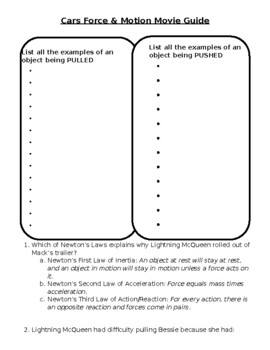Force & Motion Cars Movie Guide
- Word Document File
What educators are saying
Description
Force and motion questions for cars movie guide. Great for beginning of unit introduction. 3.P.1 Understand motion and factors that affect motion. 3.P.1.1 Infer changes in speed or direction resulting from forces acting on an object. 3.P.1.2 Compare the relative speeds (faster or slower) of objects that travel the same distance in different amounts of time. 3.P.1.3 Explain the effects of earth’s gravity on the motion of any object on or near the earth. 5.P.1 Understand force, motion and the relationship between them. 5.P.1.1 Explain how factors such as gravity, friction, and change in mass affect the motion of objects. 5.P.1.2 Infer the motion of objects in terms of how far they travel in a certain amount of time and the direction in which they travel. 5.P.1.3 Illustrate the motion of an object using a graph to show a change in position over a period of time. 5.P.1.4 Predict the effect of a given force or a change in mass on the motion of an object.



